Birdfinding.info ⇒ Common to abundant across most of its range—one of the most ubiquitous songbirds in southern Asia. In parts of its introduced range it is becoming locally abundant, and appears poised to spread wherever there are disturbed grassy habitats available to colonize.
Scaly-breasted Munia
Lonchura punctulata
Southern Asia from eastern Afghanistan to southern China, Taiwan, the Philippines, and Indonesia, where it occurs in all kinds of grassy and brushy areas, usually close to water.
Introduced widely: in eastern Australia, Hawaii, the southern U.S., the Yucatán Peninsula, the West Indies, Portugal, the Arabian Peninsula, and islands of the western Indian Ocean.
Consists of three potentially distinct forms:
“Checkered Munia”: the nominate subspecies is widely distributed in open and semi-open habitats from northeastern Afghanistan east across northern Pakistan, throughout most of India and the lowlands of Nepal to Bangladesh, and south to Sri Lanka. Mostly absent from the arid regions of western India and Pakistan.
Introduced populations are established in a growing number of areas: coastal California; coastal Texas; coastal Mississippi to the Florida Panhandle; southeastern Florida; coastal Yucatán and Quintana Roo; Cuba; Grand Cayman; Jamaica; Hispaniola; Puerto Rico; St. Kitts; Antigua; Guadeloupe; Dominica; Portugal; the Seychelles; Mauritius and Réunion; and the U.A.E. and northern Oman.
“Spotted Munia”: three subspecies (topela, yunnanensis, and cabanisi) are found from eastern Myanmar and southern China east to central-eastern China (north to Zhejiang), Hainan, Taiwan, and south through most of Thailand to southern Vietnam, and on the Philippines and northern Borneo (mainly Sabah).
Introduced populations are established on Okinawa, Yap (in the Caroline Islands), eastern Australia (mainly the eastern slope from the northern tip of Queensland south to southern New South Wales, and the main Hawaiian Islands.
“Scaled Munia”: seven similar subspecies (subundulata, fretensis, nisoria, sumbae, blasii, particeps, and baweana), found on the continent from Bhutan and Assam south through most of Myanmar, western Thailand to the Malay Peninsula and into Indonesia: Sumatra, Java, Sulawesi, to the Lesser Sundas (Bali, Lombok, Sumbawa, Flores, Sumba, Timor, Tanimbar, and adjacent smaller islands).
Identification
A medium-sized munia with a variable but distinctive pattern: solid brown above and white with a scaled pattern below has a similar appearance.
Subspecies vary significantly in the richness of their coloration, from bright rufous to plain brown, and even more in the details of the underparts scaling.

“Checkered Munia,” L. p. punctulata. (Kota, Rajasthan, India; July 15, 2018.) © Dr. Ishwar Malav
“Checkered Munia” has the boldest pattern: rich, rusty brown above with underparts that are bright white with crisp, blackish or dark brown lines.
Usually shows a strong demarcation on the upper chest between the brown throat and black-and-white pattern. The “scales” can vary somewhat in shape, but are typically close to rectangular (i.e., checkered).
The rump and tail are cinnamon-colored, and the lower back is faintly scaled.
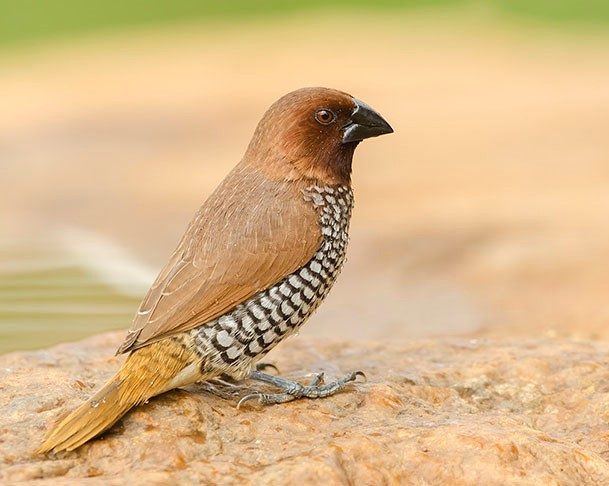
“Checkered Munia,” L. p. punctulata, showing its cinnamon rump and tail. (Bangalore, Karnataka, India; July 26, 2014.) © Rajesh Shah
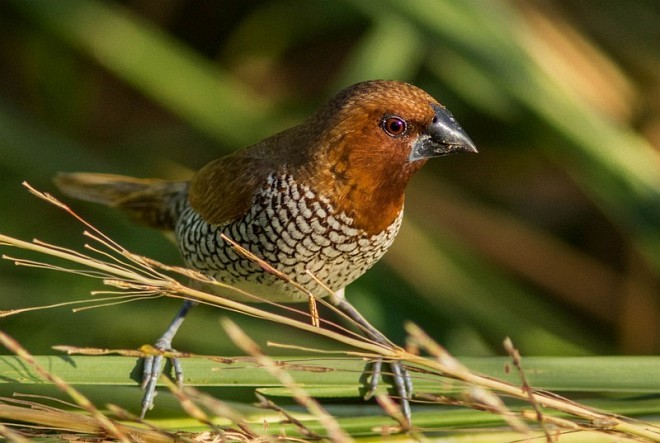
“Checkered Munia,” L. p. punctulata. (Barasat, West Bengal, India; September 30, 2016.) © Subrato Sanyal

“Checkered Munia,” L. p. punctulata, adult and immature. (Chettykulam, Tirunelveli District, Tamil Nadu, India; June 17, 2014.) © Alexandr Kvasha
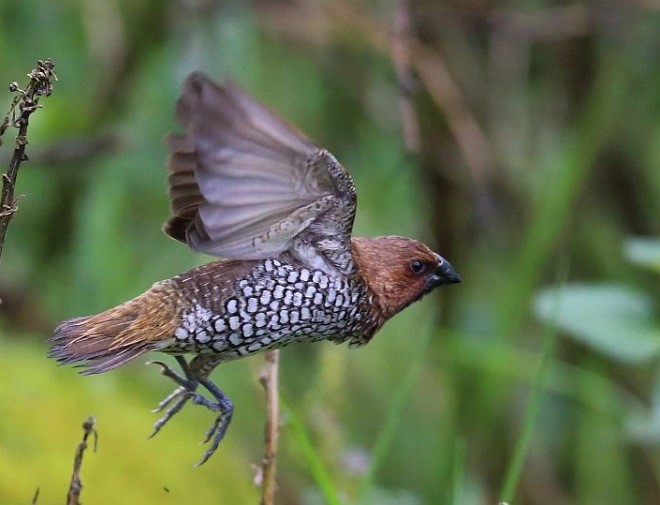
“Checkered Munia,” L. p. punctulata. (Victoria Park, Nuwara Eliya, Sri Lanka; September 26, 2015.) © Mapalagama K. Premasiri

“Checkered Munia,” L. p. punctulata, pair. (Yavatmal, Maharashtra, India; July 25, 2013.) © Go Jayant Atrey
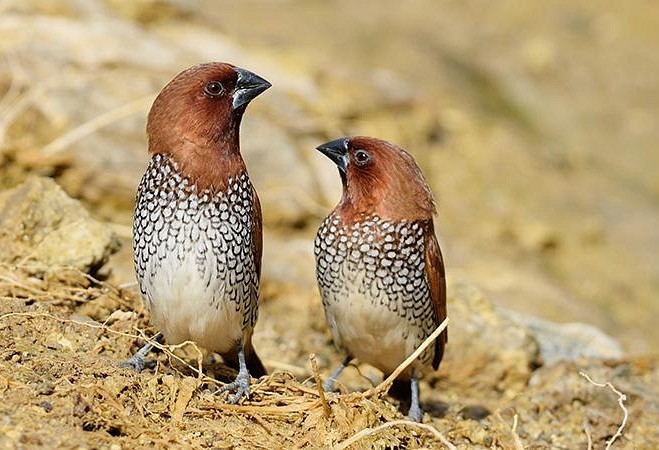
“Checkered Munia,” L. p. punctulata, pair. (Chettykulam, Tirunelveli, Tamil Nadu, India; June 22, 2014.) © Alexandr Kvasha
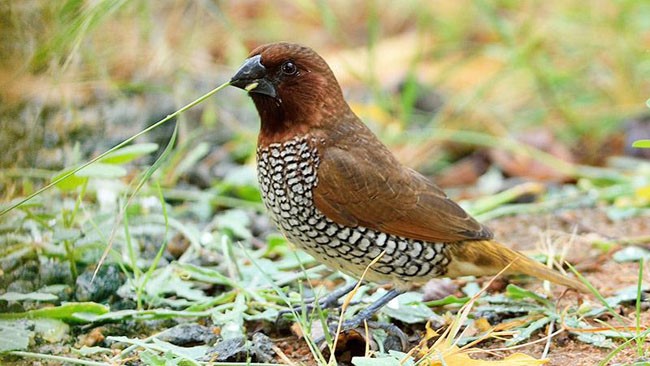
“Checkered Munia,” L. p. punctulata, holding nest material and showing its cinnamon rump and tail. (Chettykulam, Tirunelveli, Tamil Nadu, India; June 8, 2014.) © Alexandr Kvasha
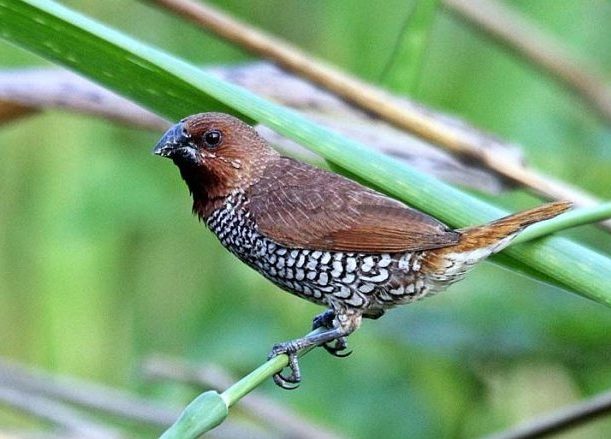
“Checkered Munia,” L. p. punctulata. (Thambuththegama, North Central Province, Sri Lanka; March 3, 2014.) © Yasanath Dhammika Bandara
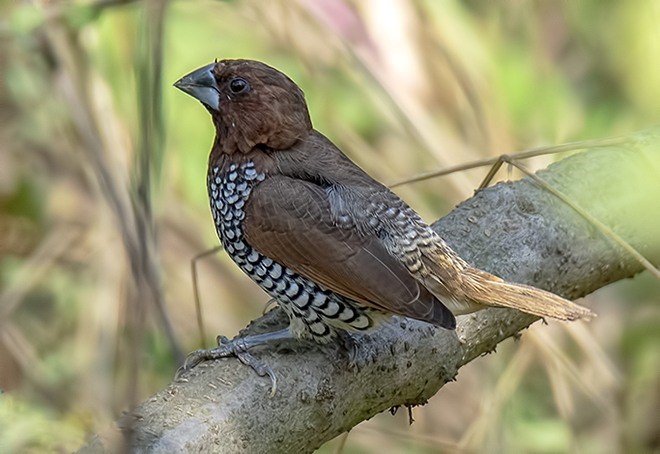
“Checkered Munia,” L. p. punctulata, showing scaled pattern on the lower back. (Gokuleshwar Lake, Alibag Taluka, Raigad District, Maharashtra, India; April 7, 2019.) © Tushar Bhagwat
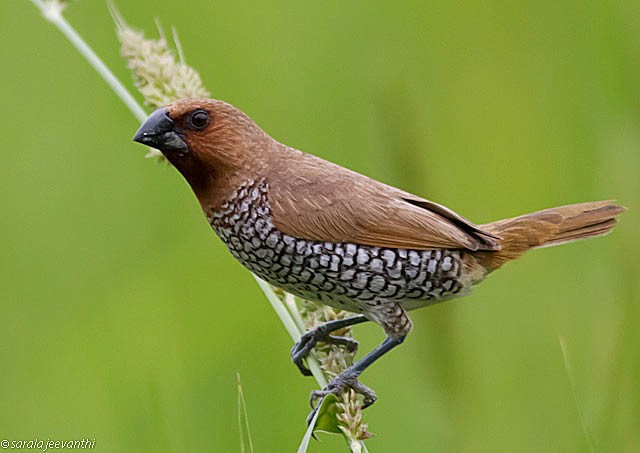
“Checkered Munia,” L. p. punctulata. (Bundala, Hambantota, Southern Province, Sri Lanka; January 25, 2013.) © Sarala Jeevanthi Gamage
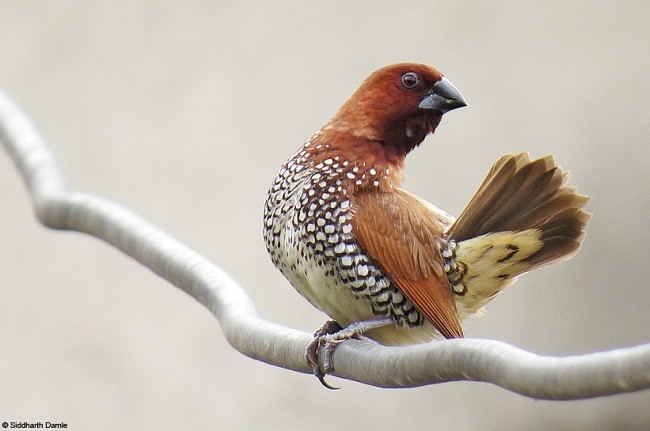
“Checkered Munia,” L. p. punctulata. (Pune, Maharashtra, India; August 5, 2013.) © Siddharth Damle
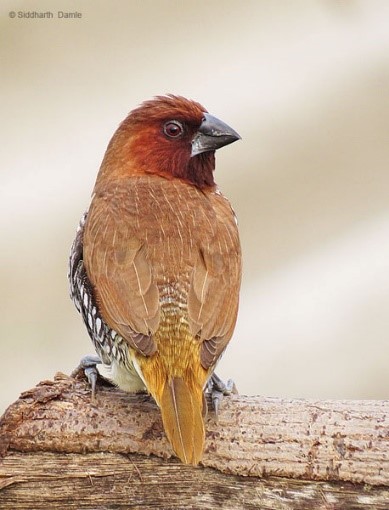
“Checkered Munia,” L. p. punctulata, showing rich cinnamon rump and tail. (Pune, Maharashtra, India; September 20, 2013.) © Siddharth Damle
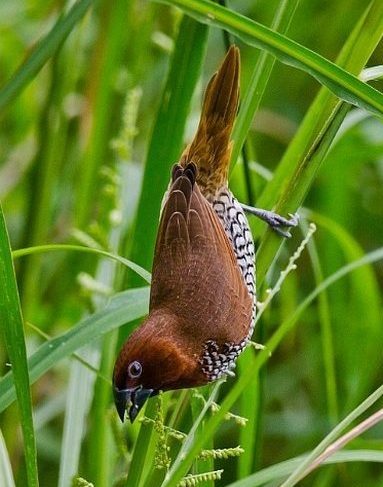
“Checkered Munia,” L. p. punctulata, showing rich cinnamon rump and tail. (Dhakuria Lake, Kolkata, West Bengal, India; June 6, 2013.) © Sumit Sengupta

“Checkered Munia,” L. p. punctulata, with an atypical scaling pattern. (Jagulia, Nadia, West Bengal, India; December 7, 2014.) © Malay Mandal

“Checkered Munia,” L. p. punctulata. (Talegaon Dabhade, Pune District, Maharashtra, India; October 22, 2016.) © Girish Ketkar

“Checkered Munia,” L. p. punctulata. (Talegaon Dabhade, Pune District, Maharashtra, India; August 2, 2018.) © Girish Ketkar

“Checkered Munia,” L. p. punctulata. (Pune, Maharashtra, India; August 20, 2011.) © Siddharth Damle
“Spotted Munia” is more uniformly colored than “Checkered.” It is warm-brown above, variably rusty, with scaly-patterned underparts that are evenly balanced between brown outlines and a whitish base color.
It usually has a darker brown throat and sometimes a pale partial collar. The “scales” are narrow and either rounded or angular, and the scales on the upper breast typically have dark central spots or chevrons.

“Spotted Munia,” L. p. topela. (Taiwan; January 5, 2011.) © Francesco Veronesi
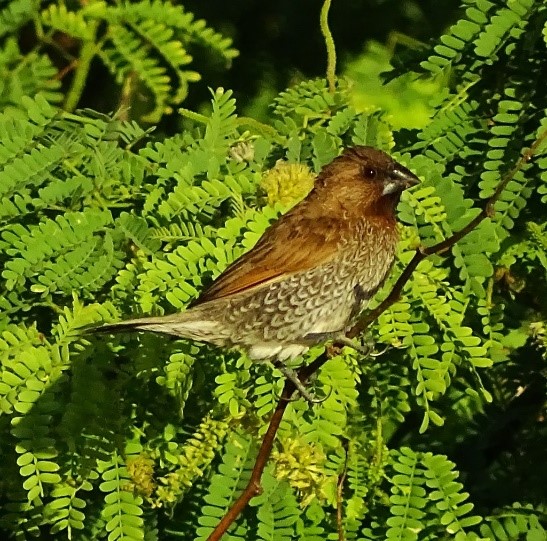
“Spotted Munia,” L. p. topela. (Maui; February 13, 2016.) © Jesse Rorabaugh

“Spotted Munia,” L. p. topela, showing an atypically checkered pattern on its flanks. (Poipu, Kauai; February 14, 2016.) © Dennis Coleman
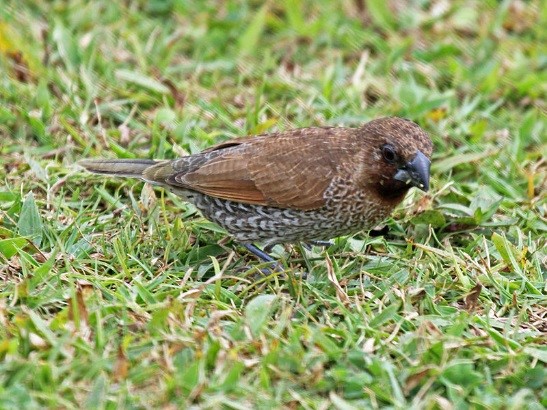
“Spotted Munia,” L. p. topela. (Kauai; February 16, 2012.) © Dick Daniels

“Spotted Munia,” L. p. cabanisi. (Mount Banahaw, Quezon, Luzon, Philippines; January 14, 2012.) © Ramon J. Quisumbing

“Spotted Munia,” L. p. cabanisi. (Palawan, Philippines; October 20, 2013.) © manakincarmelo
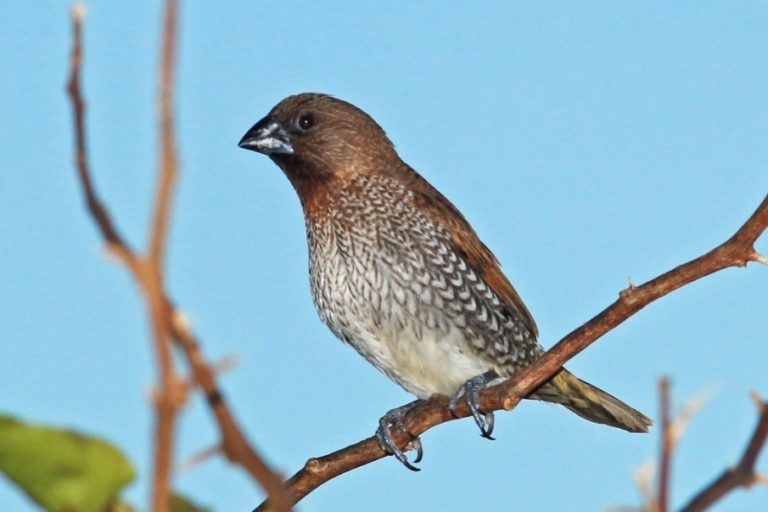
“Spotted Munia,” L. p. topela. (Hilo, Hawaii; March 30, 2017.) © Lisa Kinsey
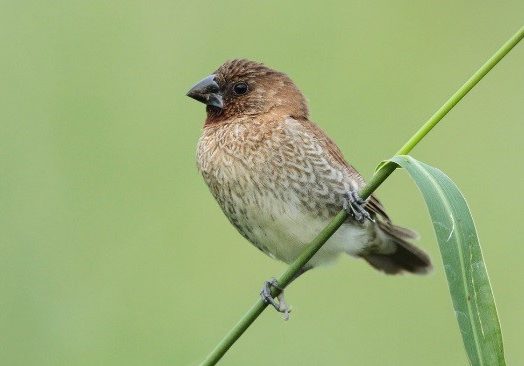
“Spotted Munia,” L. p. topela. (Huajiang, Taipei, Taiwan; October 27, 2012.) © Dave Irving
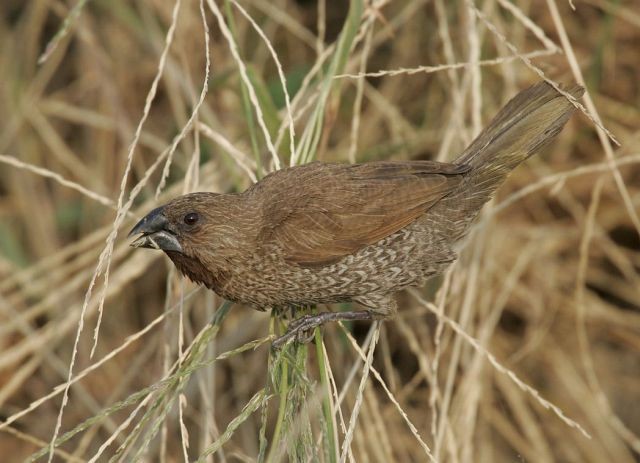
“Spotted Munia,” L. p. topela. (Hong Kong; November 8, 2006.) © Martin Hale

“Spotted Munia,” L. p. topela. (Weiwuying Metropolitan Park, Taipei, Taiwan; April 29, 2013.) © Charles Lam

“Spotted Munia,” L. p. topela. (Honolulu, Hawaii; June 14, 2008.) © Eric VanderWerf

“Spotted Munia,” L. p. topela. (Weiwuying Metropolitan Park, Taipei, Taiwan; April 29, 2013.) © Charles Lam
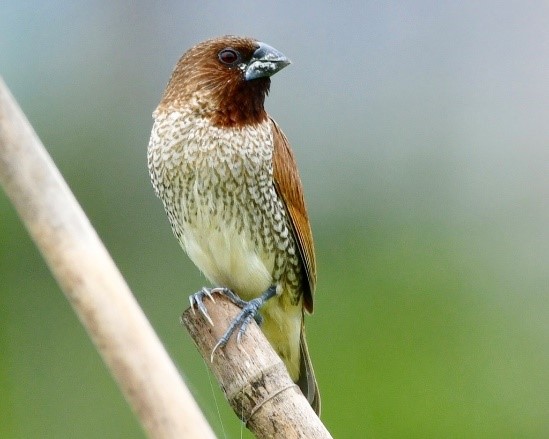
“Spotted Munia,” L. p. topela, showing an atypically checkered pattern on its flanks, with extensive white and yellow on its belly and vent. (Hong Kong; June 13, 2019.) © dickypa
“Scaled Munia” here refers to the collection of subspecies that are intermediate between the other two forms. Their underparts patterns generally resemble “Checkered” but their coloration is generally more similar to “Spotted.”
However, some of these subspecies apparently intergrade with both “Checkered” and “Spotted,” and they may have scales of various shapes and show colors that resemble either of the other forms.

“Scaled Munia,” L. p. fretensis. (Muntok, Bangka Barat, Bangka Island, Sumatra, Indonesia; December 9, 2014.) © Muhammad Iqbal
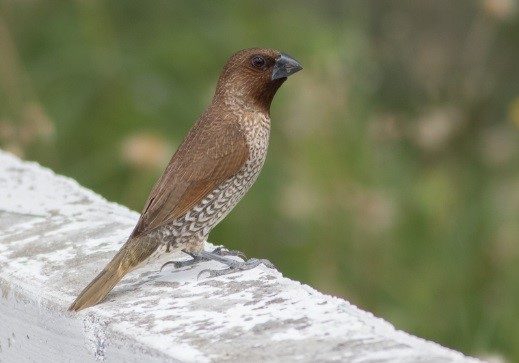
“Scaled Munia,” L. p. fretensis. (Khao Daeng, Thailand; August 21, 2017.) © Steve Nesbitt

“Scaled Munia,” L. p. particeps. (Gardenia Country Inn, Manado, northern Sulawesi, Indonesia; June 17, 2013.) © Marie-France Grenouillet
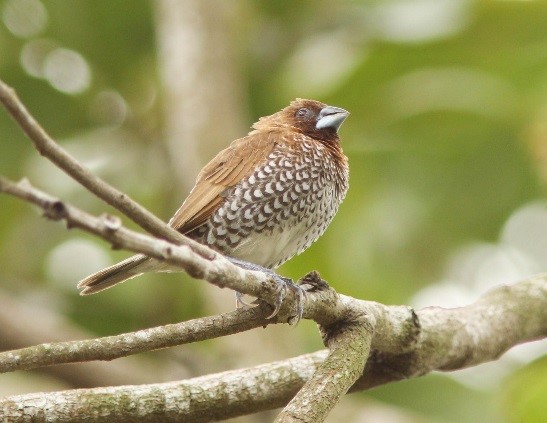
“Scaled Munia,” L. p. particeps. (Sulawesi, Indonesia; October 13, 2011.) © David Beadle
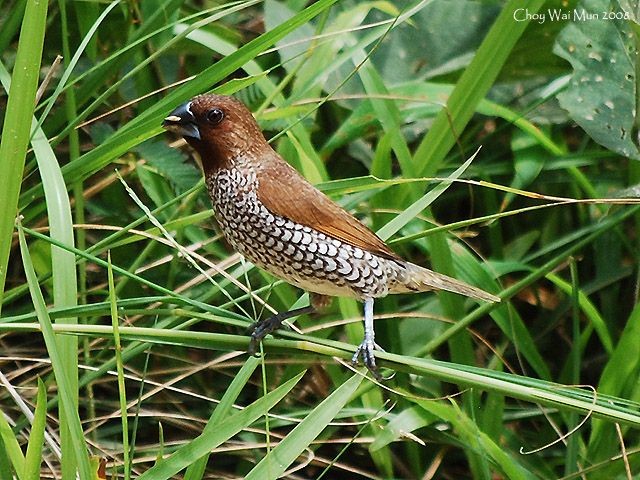
“Scaled Munia,” L. p. nisoria. (Bukit Gambir, Penang, Malaysia; April 20, 2008.) © Choy Wai Mun

“Scaled Munia,” L. p. nisoria. (Padang Bai, Bali, Indonesia; January 7, 2017.) © Andrew Hogg
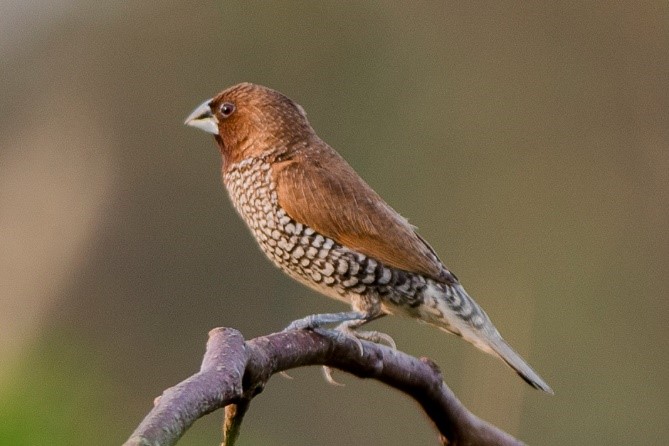
“Scaled Munia,” L. p. nisoria. (Lippo Karawaci, Banten Province, Java, Indonesia; April 19, 2018.) © Dr. Vijay Anand Ismavel

“Scaled Munia,” L. p. nisoria. (Ipoh City, Perak, Malaysia; February 20, 2010.) © Amar-Singh HSS
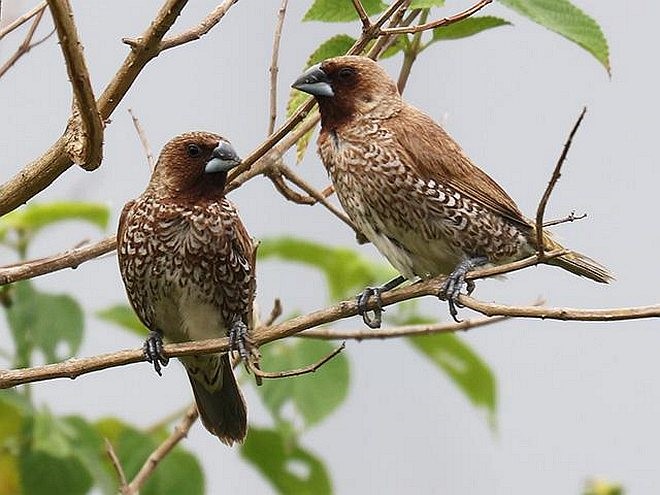
“Scaled Munia,” L. p. particeps. (Parangloe Village, Tamalanrea Subdistrict, Makassar City, South Sulawesi Province, Indonesia; May 11, 2017.) © Kama Jaya Shagir
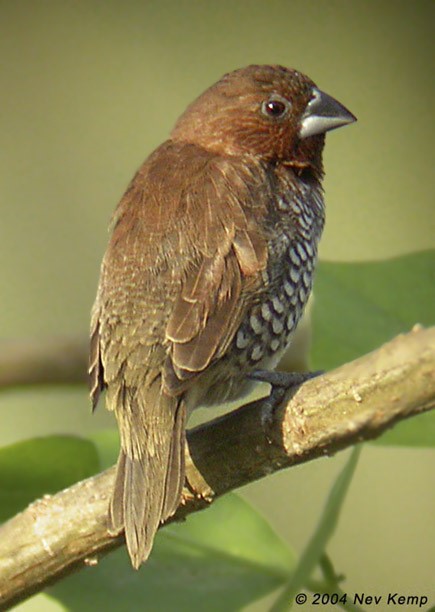
“Scaled Munia,” L. p. sumbae. (Waingapu, East Sumba, Indonesia; November 3, 2004.) © Neville Kemp
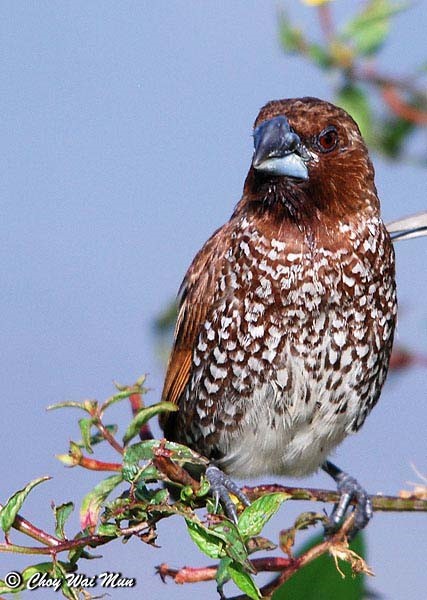
“Scaled Munia,” L. p. nisoria. (Kubang Semang, Penang, Malaysia; October 6, 2011.) © Choy Wai Mun
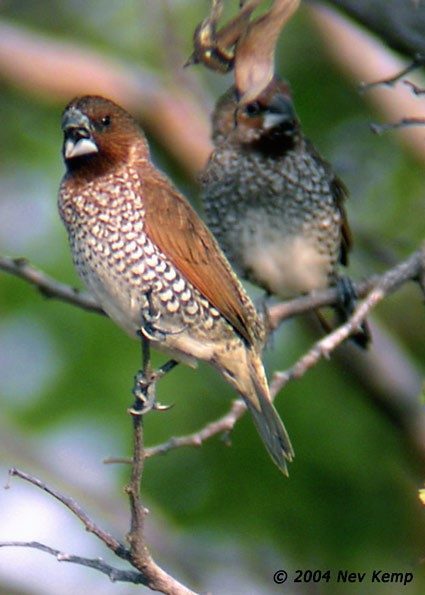
“Scaled Munia,” L. p. sumbae. (Waingapu, East Sumba, Indonesia; November 3, 2004.) © Neville Kemp
Immature Plumages. Immature Scaly-breasted Munias come in several shades of pale brown: darker above and paler below. They are essentially patternless and can easily be confused with many other immature finches. “Checkered” and “Scaled” are warmer brown above and buffier below than “Spotted Munia.”
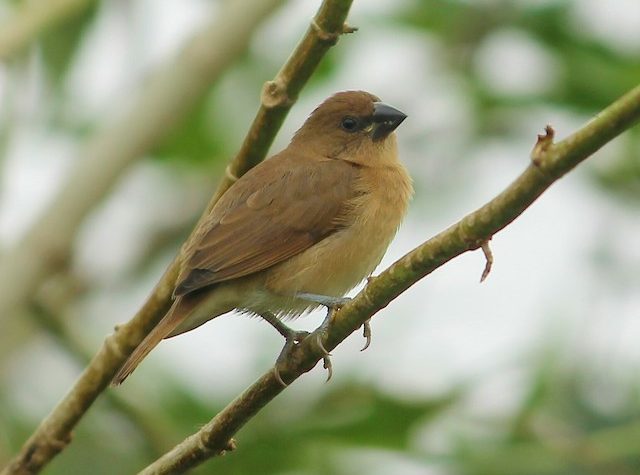
“Checkered Munia,” L. p. punctulata, immature. (Bangalore University Campus, Karnataka, India; September 4, 2016.) © Shreyan M L
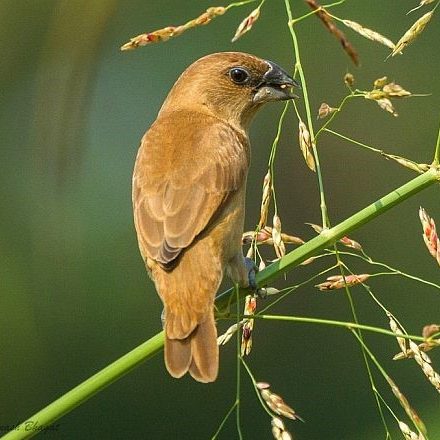
“Checkered Munia,” L. p. punctulata, immature. (Bhandup Pumping Station, Mumbai, Maharashtra, India; October 6, 2015.) © Avinash Bhagat
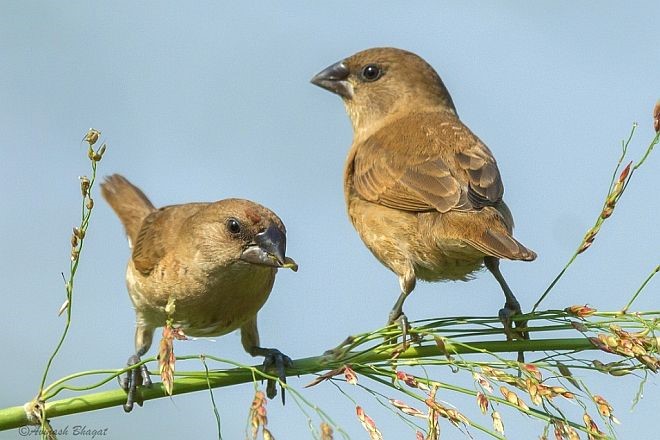
“Checkered Munia,” L. p. punctulata, immatures. (Bhandup Pumping Station, Mumbai, Maharashtra, India; October 6, 2015.) © Avinash Bhagat

“Checkered Munia,” L. p. punctulata, immature. (Alibag, Raigad District, Maharashtra, India; January 26, 2015.) © Tushar Bhagwat
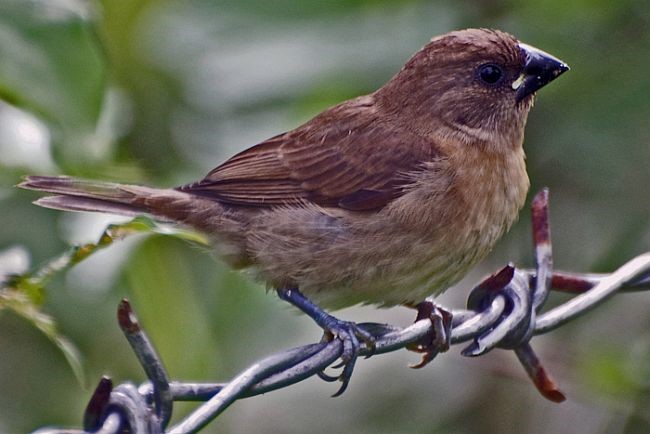
“Scaled Munia,” L. p. subundulata, immature. (Makunda Christian Hospital Campus, Karimganj District, South Assam, India; September 19, 2010.) © Vijay Anand Ismavel

“Checkered Munia,” L. p. punctulata, immature. (Kalyan Gandhari, Maharashtra, India; December 30, 2012.) © Girish Ketkar
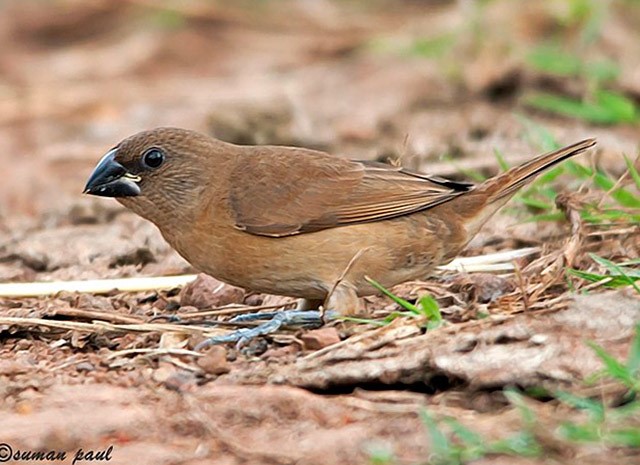
“Checkered Munia,” L. p. punctulata, immature. (Baidyabati, Hoogly, West Bengal, India; September 2, 2012.) © Suman Paul
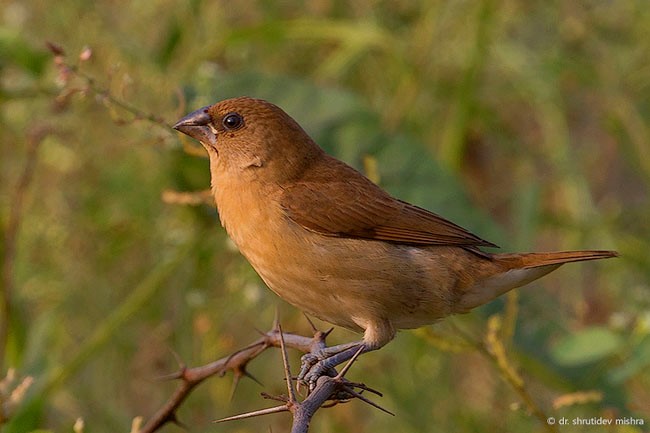
“Checkered Munia,” L. p. punctulata, immature. (Bilaspur, Chhattisgarh, India; October 30, 2016.) © Dr. Shrutidev Mishra
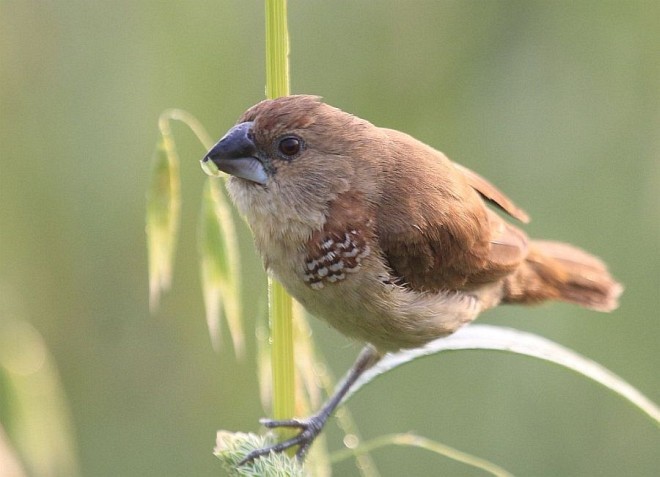
“Checkered Munia,” L. p. punctulata, immature. (Geeta Colony, Delhi, India; March 9, 2014.) © Rajesh Kalra
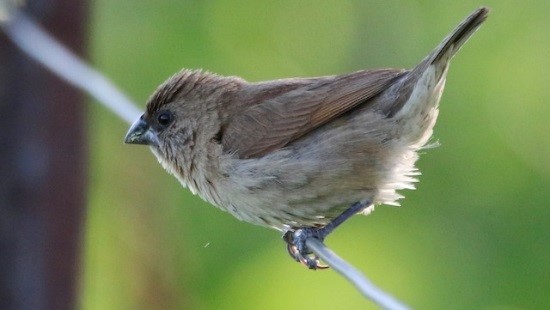
“Spotted Munia,” L. p. topela, immature. (Hawkesbury, New South Wales, Australia; August 6, 2017.) © Thalia & August
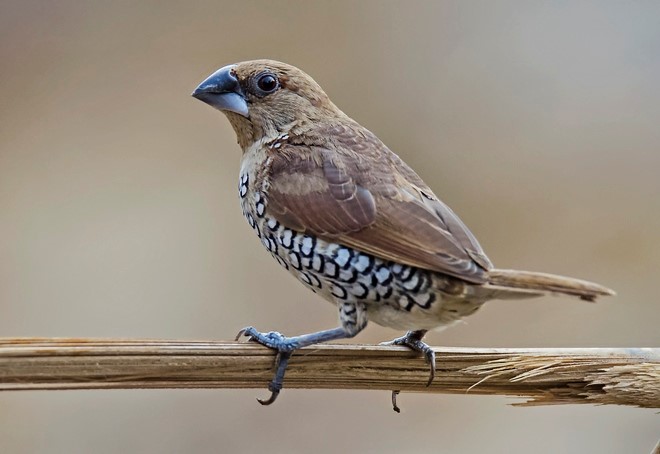
“Checkered Munia,” L. p. punctulata, molting into adult plumage. (Alibag, Raigad District, Maharashtra, India; March 26, 2017.) © Tushar Bhagwat
Notes
Polytypic species consisting of eleven recognized subspecies. The nominate subspecies is often recognized as a distinct form, “Checkered Munia,” and the remaining subspecies divide naturally into two groups that seem appropriately tagged as “Spotted Munia” and “Scaled Munia.”
Traditional English and avicultural names include Nutmeg Mannikin, Spotted Munia, Spice Finch, and Ricebird.
Forms of Scaly-breasted Munia. Based on plumage coloration and patterns, the Scaly-breasted Munia appears to consist of three distinct forms or species, but the evidence points to the conclusion that it is a single species with a spectrum of appearances that intergrade into one another in zones of overlap.
The subspecies most widely considered separable from the rest is the nominate punctulata, “Checkered Munia,” of the Indian subcontinent—it has the most brightly colored upperparts, boldest underparts pattern, and nearly rectangular scaling that does not extend to the undertail coverts.
At the opposite end of the spectrum, the Chinese, Philippine, and Southeast Asian “Spotted Munia” (yunnanensis, topela, and cabanisi) shows duller shades of brown above and below, and the underparts pattern consists of scales that are rounded or angular, with spots or chevrons in their centers, and which extend to the undertail coverts.
The remaining subspecies (provisionally “Scaled Munia”) combine features of “Checkered” and “Spotted.” In coloration, they resemble “Spotted” (with some that appear intermediate between “Checkered” and “Spotted”), whereas the patterns of their scaling resemble that of “Checkered.” This group includes two Southeast Asian subspecies (subundulata and fretensis) and all of the strictly Indonesian subspecies (nisoria, sumbae, blasii, particeps, and baweana). In these populations, whose natural range stretches from Bhutan south through western Indochina and the Malay Peninsula to eastern Indonesia, most adults look like a muted version of the “Checkered Munia.” They appear to intergrade with both “Checkered” and “Spotted” in the zones of contact.
In sum, the variation of appearances within “Scaled Munia” suggests that it represents the central “stem” of L. punctulata, and that the “Checkered” and “Spotted” are regional branches that are in the process of diverging from it.
References
Alderfer, J., and J.L. Dunn. 2014. National Geographic Complete Birds of North America (Second Edition). National Geographic Society, Washington, D.C.
Anonymous. Lonchura punctulata (Linnaeus, 1758). India Biodiversity Portal. https://indiabiodiversity.org/biodiv/species/show/239877. (Accessed April 18, 2018.)
BirdLife International 2016. Lonchura punctulata. The IUCN Red List of Threatened Species 2016: e.T22719821A94646304. http://dx.doi.org/10.2305/IUCN.UK.2016-3.RLTS.T22719821A94646304.en. (Accessed July 3, 2019.)
Brazil, M. 2009. Birds of East Asia. Princeton University Press, Princeton, N.J.
Duncan, R.A. 2009. The Status of the Nutmeg Mannikin (Lonchura punctulata) in the Extreme Western Panhandle of Florida. Florida Field Naturalist 37:96-97.
eBird. 2019. eBird: An online database of bird distribution and abundance. Cornell Lab of Ornithology, Ithaca, N.Y. http://www.ebird.org. (Accessed July 3, 2019.)
National Institute for Environmental Studies, Invasive Species of Japan, Lonchura punctulata. https://www.nies.go.jp/biodiversity/invasive/DB/detail/20200e.html. (Accessed April 18, 2018.)
Payne, R. 2018. Scaly-breasted Munia (Lonchura punctulata). In Handbook of the Birds of the World Alive (J. del Hoyo, A. Elliott, J. Sargatal, D.A. Christie, and E. de Juana, eds.). Lynx Edicions, Barcelona. https://www.hbw.com/node/61187. (Accessed July 3, 2019.)
Pyle, R.L., and P. Pyle. 2017. The Birds of the Hawaiian Islands: Occurrence, History, Distribution, and Status. Version 2. B.P. Bishop Museum, Honolulu, Hawaii. http://hbs.bishopmuseum.org/birds/rlp-monograph/.
Raffaele, H., J. Wiley, O. Garrido, A. Keith, and J. Raffaele. 1998. A Guide to the Birds of the West Indies. Princeton University Press, Princeton, N.J.
Restall, R. 1996. Munias and Mannikins. Yale University Press, New Haven.

